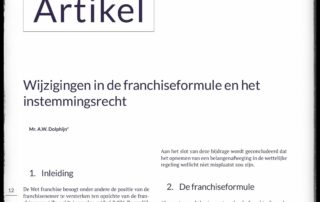Include damage estimate from customer base
On 17 March 2015, the Court of Appeal in Den Bosch ruled in a judgment (ECLI:NL:GHSHE:2015:935) on the question of how to calculate the damage that a former franchisee had inflicted on a franchisor by franchisor to the former franchisee’s new business.
Although it is not clear from the judgment whether the parties had intended to conclude a franchise agreement, there is at least a legal relationship that resembles a franchise relationship.
The franchisor operated a fitness business which at one point was operated at the expense and risk of a franchisee. The franchisee rented the business premises and inventory from the franchisor. Based on the agreement, the franchisee is offered the opportunity to take over the customer base.
The franchisee has terminated the cooperation and has not used the option to take over the customer base. On the other hand, the franchisee started his own gym, approaching the customers of the franchise establishment with the announcement that the company would be moving and would continue under a new name at a new location. Thus, 209 members of the franchise organization would have transferred to the company of the former franchisee.
The franchisor has taken the former franchisee to court and demanded that the former franchisee be liable for the damage, to be determined by the state. The franchisor succeeds in this.
In the present proceedings, the franchisor is claiming the extent of the damage to be compensated. It therefore concerns the state of damage procedure. In the first instance, the court ruled that the extent of the damage had not been sufficiently established and rejected the claim for compensation of the damage. An appeal against this judgment is before the Court of Appeal.
The Court of Appeal has established that the extent of the damage must be determined by comparing the situation as it actually is with the situation as it would (presumably) have been if the event causing the damage had not taken place. The Court further notes that the damage cannot be estimated on the basis of the positive or negative result achieved with a gym, because this depends on various circumstances, including the person of the entrepreneur and the way in which he runs the business. Because, as a result of the missing customer base, less rent could be charged on the one hand and on the other hand because a lead time was needed to rebuild the customer base, the Court of Appeal considers it reasonable to assume a compensation of three months’ rent, as well as a compensation of six months rent for half the rent. On balance, the damage is therefore set at half a year’s rent.
Estimating damage as a result of an unlawful act, for example the unlawful transfer of a customer base, is a difficult matter. In some cases this is quite disappointing.
Mr AW Dolphijn – Franchise lawyer
Ludwig & Van Dam Franchise attorneys, franchise legal advice. Do you want to respond? Mail to dolphijn@ludwigvandam.nl

Other messages
Mitigation of fine due to ‘dominant position’ of franchisor
Mitigation of fine due to 'dominant position' of franchisor ...
It is a non-competition clause at the end of the lease
In the judgment of 26 March 2024, ECLI:NL:GHSHE:2024:1035, the Court ...
Looking ahead: Bottlenecks at the end of the franchise agreement
Of course, everyone starts a collaboration with good courage. But ...
Not just a successful appeal to incorrect forecasts
Not just a successful appeal to incorrect forecasts Introduction ...
Changes to the franchise formula and the right of consent
An article by Mr. was published in the leading legal ...
The National Franchise podcast
Guests on the National Franchise podcast are: Theodoor Ludwig ...







